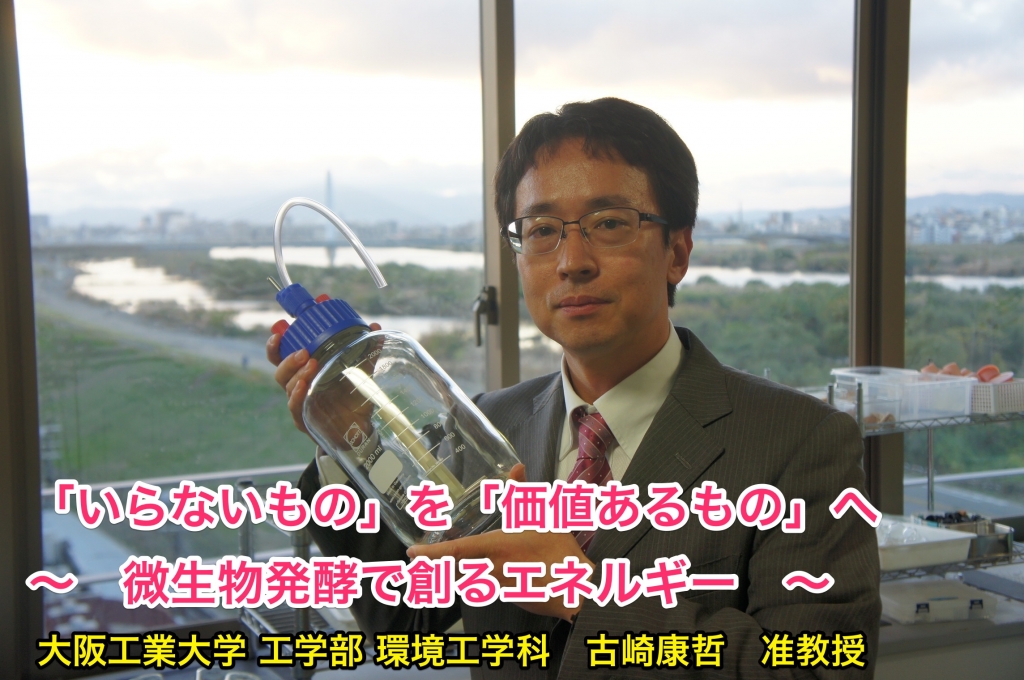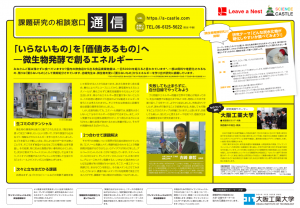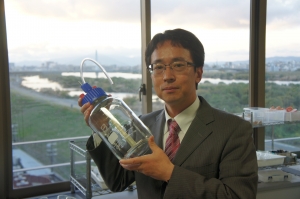- Notice
- Announcements for middle and high school students
- over the counter communication
- Consultation Service for Proposed Research
- Notice of Kansai Conference
Issue Research Consultation News Letter (February 16, 2016) From "Unwanted Items" to "Valuable Items" - Energy Created by Microbial Fermentation
2017.02.16
.
The PDF file is in poster format for easy posting! Please download it!
Issue Research Consultation Service News Letter vol. 4 Dr. Furusaki (5051 downloads)

Do you eat your rice without leaving any leftovers? It is said that the amount of food waste from restaurants in Japan exceeds 5,000 tons per day.note (supplementary information) symbol. Some are turned into feed or compost, while the rest are incinerated as "unwanted" materials. Dr. Furusaki is challenging research into the use of microorganisms to create energy from "unwanted" materials.
Estimated values for FY2012, from the Ministry of Agriculture, Forestry and Fisheries FY2014 commissioned project to survey the status of food industry recycling (survey to determine the amount of edible and inedible parts of food waste, etc.).
Potential of food waste
Fascinated by the environmental purification ability of microorganisms, the professor decided to produce energy from food scraps and leftovers from the university's cafeteria, hoping to "do something useful with microorganisms. One of the difficulties in handling food scraps is that their composition is not constant from day to day. We first investigated the types and proportions of food scraps from the cafeteria, and found that they were particularly rich in carbohydrates. The carbohydrates are glucose (C6indecent12O6The key to biomass power generation is ethanol and methane gas, which are produced by breaking down glucose.
Challenges that stand one after another
The process begins by dehydrating and pulverizing the garbage, then cutting out the glucose in the carbohydrates and performing the necessary saccharification to make it easier for the microorganisms to feed. Ethanol is then produced when fed with yeast and methane is produced when fed with anaerobic bacteria. Since the amount of energy assumed to be obtained is not large, it is not likely that this process would use the same amount of transportation energy as normal garbage collection. Therefore, the professor aimed to develop a device that could be installed in restaurants.
However, even with continued improvements, the ethanol fermentation process requires larger equipment to recover sufficient energy. Methane fermentation takes as long as 20 days, and the resulting gas contains as much as 501 TP3T of carbon dioxide.
The two together solve the problem.
When we began to see the limitations of each experiment and were on the verge of giving up, the idea of combining ethanol fermentation and methane fermentation to shorten fermentation time came to mind. The idea of combining ethanol fermentation and methane fermentation to shorten fermentation time came to me. Glucose (C6indecent12O6) has six C's bonded to it. Ethanol (C2indecent5OH) are two, and methane (CH4), there is only one. Methane fermentation of glucose is time-consuming because it suddenly needs to cut many C bonds. Therefore, ethanol fermentation is performed once to remove excess CO2and then tried to remove the methane gas and then methane it. This allowed us to generate methane gas with a high concentration in a short period of time, leading to a discovery that solved the problem in one fell swoop.
Don't stop when you make a mistake, but try to do it from your perspective.
Waste and energy issues are a growing concern around the world, and the teacher's vision is 10 years away from commercialization. At the same time, looking back on the past, he said, "After 10 years of work, we finally succeeded. We have had nothing but failures, but by not giving up and taking action, we will see results. Even if you fail, taking action makes the next step clear." He tells the story. He continues his research to find themes that he enjoys and wants to know even if he fails, and to seek the moment when value is created.
 |
| Associate Professor Yasutetsu Furusaki, Department of Environmental Engineering, Osaka Institute of TechnologyCompleted Graduate School of Engineering, Osaka Institute of Technology (Doctor of Engineering)After graduation, worked for a water supply and sewage design consultant company. He worked there for about 7 years, providing technical guidance to a subsidiary (in Nepal), conducting joint research in industry-academia collaboration, and working on water supply and sewage geographic information systems (GIS) and basic waterworks planning. He has been a lecturer at Osaka Institute of Technology since 2007 and in his current position since 2011. |
<Let's use it! What is the consultation service for research issues?
This is a new service in which RIVERNESS and researchers from universities and companies will answer questions and concerns that arise in your daily research activities. Please feel free to apply. (To use this service, you need to log in to Teachia.)
For more information, click here:https://s-castle.com/madoguchi/
Research Practice Partner Universities
Manufacturing DivisionOsaka Institute of Technology
| Teachers who have registered as "Education Support Teachers" will receive the latest Science Bridge News every Tuesday as a PDF file edited into an easy-to-use wall newspaper format for use in schools. For more details, please click here ⇒.Science Bridge News for School |
.
The PDF file is in poster format for easy posting! Please download it!
Issue Research Consultation Service News Letter vol. 4 Dr. Furusaki (5051 downloads)

